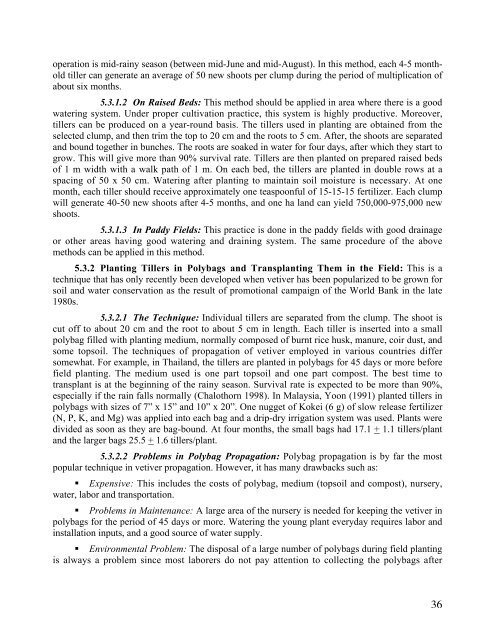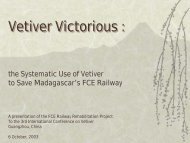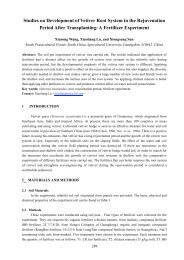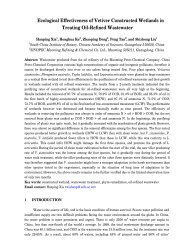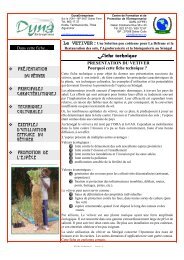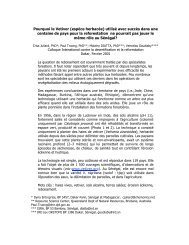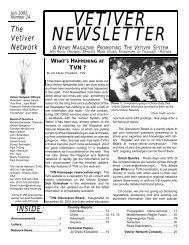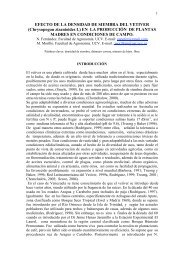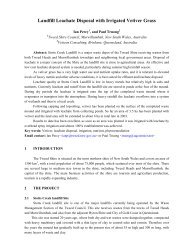Training manual - The Vetiver Network International
Training manual - The Vetiver Network International
Training manual - The Vetiver Network International
Create successful ePaper yourself
Turn your PDF publications into a flip-book with our unique Google optimized e-Paper software.
operation is mid-rainy season (between mid-June and mid-August). In this method, each 4-5 monthold<br />
tiller can generate an average of 50 new shoots per clump during the period of multiplication of<br />
about six months.<br />
5.3.1.2 On Raised Beds: This method should be applied in area where there is a good<br />
watering system. Under proper cultivation practice, this system is highly productive. Moreover,<br />
tillers can be produced on a year-round basis. <strong>The</strong> tillers used in planting are obtained from the<br />
selected clump, and then trim the top to 20 cm and the roots to 5 cm. After, the shoots are separated<br />
and bound together in bunches. <strong>The</strong> roots are soaked in water for four days, after which they start to<br />
grow. This will give more than 90% survival rate. Tillers are then planted on prepared raised beds<br />
of 1 m width with a walk path of 1 m. On each bed, the tillers are planted in double rows at a<br />
spacing of 50 x 50 cm. Watering after planting to maintain soil moisture is necessary. At one<br />
month, each tiller should receive approximately one teaspoonful of 15-15-15 fertilizer. Each clump<br />
will generate 40-50 new shoots after 4-5 months, and one ha land can yield 750,000-975,000 new<br />
shoots.<br />
5.3.1.3 In Paddy Fields: This practice is done in the paddy fields with good drainage<br />
or other areas having good watering and draining system. <strong>The</strong> same procedure of the above<br />
methods can be applied in this method.<br />
5.3.2 Planting Tillers in Polybags and Transplanting <strong>The</strong>m in the Field: This is a<br />
technique that has only recently been developed when vetiver has been popularized to be grown for<br />
soil and water conservation as the result of promotional campaign of the World Bank in the late<br />
1980s.<br />
5.3.2.1 <strong>The</strong> Technique: Individual tillers are separated from the clump. <strong>The</strong> shoot is<br />
cut off to about 20 cm and the root to about 5 cm in length. Each tiller is inserted into a small<br />
polybag filled with planting medium, normally composed of burnt rice husk, manure, coir dust, and<br />
some topsoil. <strong>The</strong> techniques of propagation of vetiver employed in various countries differ<br />
somewhat. For example, in Thailand, the tillers are planted in polybags for 45 days or more before<br />
field planting. <strong>The</strong> medium used is one part topsoil and one part compost. <strong>The</strong> best time to<br />
transplant is at the beginning of the rainy season. Survival rate is expected to be more than 90%,<br />
especially if the rain falls normally (Chalothorn 1998). In Malaysia, Yoon (1991) planted tillers in<br />
polybags with sizes of 7” x 15” and 10” x 20”. One nugget of Kokei (6 g) of slow release fertilizer<br />
(N, P, K, and Mg) was applied into each bag and a drip-dry irrigation system was used. Plants were<br />
divided as soon as they are bag-bound. At four months, the small bags had 17.1 + 1.1 tillers/plant<br />
and the larger bags 25.5 + 1.6 tillers/plant.<br />
5.3.2.2 Problems in Polybag Propagation: Polybag propagation is by far the most<br />
popular technique in vetiver propagation. However, it has many drawbacks such as:<br />
Expensive: This includes the costs of polybag, medium (topsoil and compost), nursery,<br />
water, labor and transportation.<br />
Problems in Maintenance: A large area of the nursery is needed for keeping the vetiver in<br />
polybags for the period of 45 days or more. Watering the young plant everyday requires labor and<br />
installation inputs, and a good source of water supply.<br />
Environmental Problem: <strong>The</strong> disposal of a large number of polybags during field planting<br />
is always a problem since most laborers do not pay attention to collecting the polybags after<br />
36


